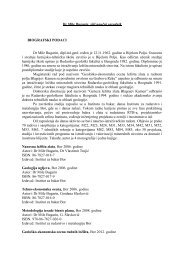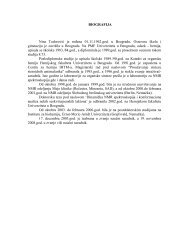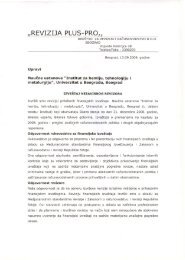Радно искуство - IHTM - Универзитет у Београду
Радно искуство - IHTM - Универзитет у Београду
Радно искуство - IHTM - Универзитет у Београду
Create successful ePaper yourself
Turn your PDF publications into a flip-book with our unique Google optimized e-Paper software.
D. MARINKOVIĆ et al.: MOTOR FUEL CONSUMPTION IN SERBIA Hem. ind. 66 (3) 413–423 (2012)<br />
Figure 5. Development of the alternative fuels impact factor in Serbia (2001–2025).<br />
tor fuels with alternative fuels, in order to protect the<br />
environment and relieve pressures arising as a result of<br />
reduction in crude oil stocks. The most commonly used<br />
alternative fuels are biodiesel, electricity, ethanol, hydrogen,<br />
methanol, natural gas, propane, etc.<br />
In March 2006, the Council of Europe called on the<br />
leaders of European countries to meet the steps of<br />
using renewable energy sources in a plan such that by<br />
2015, energy from renewable sources would make up<br />
15% of total energy consumption, and by 2020, 25%<br />
[21]. As for the transport sector, the ratio of renewable<br />
fuels in the total quantity of produced fuel should<br />
reach 5% by 2015 and 10% by 2020 [22–24].<br />
As Serbia moves closer to EU membership, it will<br />
have to comply with all the decisions taken by EU institutions.<br />
However, Serbia has not yet been able to fully<br />
implement all the recommendations and directives regarding<br />
the dynamics of replacing fossil fuels with renewable<br />
fuels. Therefore, it is unrealistic to expect that<br />
the successful implementation of already mentioned<br />
dynamics of the replacement of fossil fuels in Serbia<br />
would be realized. All new EU members have received<br />
benefits in terms of these deadlines. Time limits and<br />
extent of substitution of traditional fossil fuels with renewable<br />
fuels in this paper for Serbia moved to 5% by<br />
2020 and 10% by 2025.<br />
P5 – The impact factor of vehicles air conditioning<br />
(Figure 8)<br />
Passenger car manufacturers provide data indicating<br />
that the use of air conditioning while driving<br />
increases fuel consumption by an average of about 6%<br />
[25]. The assessment adopted in this analysis is that the<br />
air conditioner in the vehicle is used an average of 60<br />
days a year. This would mean, looking at individual<br />
vehicles, that the effect of using air conditioning on fuel<br />
consumption is positive and that is about 1% per annum.<br />
In order to estimate how much the use of air conditioners<br />
in vehicles affect fuel consumption it was<br />
necessary to introduce additional information year by<br />
year: the total number of registered vehicles in Serbia,<br />
Auk,j, and the number of vehicles equipped with air conditioning,<br />
Ak,j:<br />
F5,j = 1 + 0.01Ak,j/Auk,j<br />
(2)<br />
The total number of registered vehicles in Serbia<br />
was obtained based on the equation:<br />
Auk,j = STj×Motorizationj/1000 (3)<br />
where STj represents population number per year j;<br />
Motorizationj is number of vehicles per 1000 inhabitants<br />
in a chosen year j.<br />
It was noted that the correlation of development of<br />
motorization and GDP per capita follows a sigmoid or<br />
“S curve” [26]. In the case of Serbia, the correlation of<br />
GDP PPPPC and motorization when “S curve’’ is applied<br />
would look like as seen in Figure 6.<br />
In order to predict how Auk,j will change in the<br />
future, as motorization had already been calculated, it<br />
was necessary to predict population trends. The Statistical<br />
Office of Serbia includes the prediction of population<br />
trends in Serbia until the 2027 and for some years:<br />
2012, 2017, 2022 and 2027 [27].<br />
To determine the parameter Ak,j, an assessment was<br />
made providing the percentage of vehicles that have air<br />
conditioning based on the production year of vehicles,<br />
as shown in Table 1. Then, the number of air-conditioned<br />
vehicles in Serbia was determined by the equation:<br />
6<br />
Ak,j = PKAj × AEl,<br />
j<br />
l=<br />
0<br />
(4)<br />
where PKAj represents percentage of air-conditioned<br />
A is number of vehicles in the<br />
vehicles in the year j; El, j<br />
417







